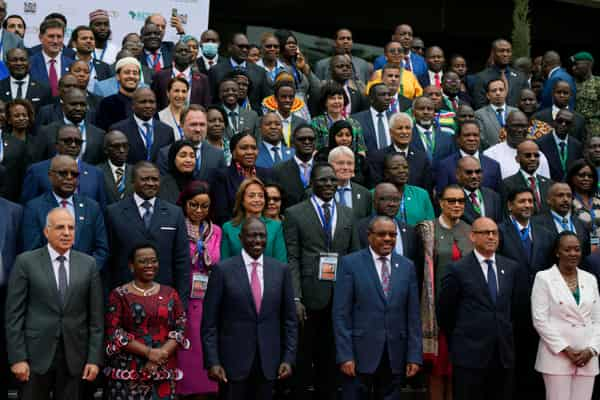World leaders of about 197 countries, and with European Union, making 198, began holding yesterday what may turn out to be a most important summit in a long while, given the theme of the conference. The theme is “Climate Action and Implementation.” What brings them together yearly is the future of the earth in the light of devastation and the incalculable abuse to which it has been subjected largely in the pursuit of modern living. The Vice-President, Kashim Shettima, is at the meeting, standing in for President Bola Tinubu. He left the country on Wednesday.
The summit is a product of a 1987 report by a 22-member UN’s World Commission on Environment and Development. The Brundtland report captioned “Our Common Future,” worries about the state of the planet earth and what will be left of it for the future generation, what The Times of London at the time called “this fragile earth.’’ The report stressed that never should an economic decision be taken without regard to its consequences on the environment.
The devastation to the environment borne out largely of economic activities, has come in various guises—pollution, deep and extensive damage to the earth-crust, emission of hardly quantifiable amount of carbon dioxide into the atmosphere and destruction of vegetation and rivers.
Already, scientists have discovered that the carbon dioxide emission has altered the stratospheric balance, perforating the ozone layer such that there is unshielded release of harmful ultraviolet radiation, which apart from inflicting skin cancer on man, escalates atmospheric warming. Deformities in fish and animals linked to radiation increases were reported. The scientists also discovered the largest ever hole in the ozone layer over the Antarctic. The ultraviolet rays deplete the community of planktons which absorb carbon dioxide.
When added to that the devastation of vegetation, plant life in general that absorbs carbon and through photosynthesis in the activities of Nature Beings also called Elemental Beings, turn it into oxygen which man and animals need, it leads not only to warming, it engenders shortfall in the quantity and quality of oxygen available. Indeed, it is a tragedy in no small measure. The harm is unspeakable. With the gradual extermination of planktons, increased heat and pollution are released into the environment resulting in climatic changes.
The warming is laden with the danger of melting Ice-lands which is calculated will swell water level by as much as 20 centimeters (8 inches) come the year 2030 which today is only five years away and 65cm in 2100. By that time as scientists predict, many coastal lands will be washed off or completely submerged, places such as Bangladesh and parts of Britain and West African coastline. Pray that the prediction of Professor Ijeoma, formerly of Ambrose Ali University, that Victoria Island may be hit does not come to pass. At the time he made the prediction he was dismissed as exhibiting deficient knowledge of oceanography and land reclamation. The severity of the climate change even now cannot go unnoticed.
Each year, the summit is seen as raising hope of a giant leap for mankind even if at the end of the huge gathering not more than rhetorics and huge piles of presented papers over which no action is taken come out of it. It arouses world consciousness to the apocalyptic future facing mankind. The awareness is imperative for nations, corporate organisations as well as individual attitude to the casual manner the earth and, by extension, the environment has been treated.
This newspaper, The Guardian, on 01 August, this year, painted the troubling picture of the seriousness of the climate crisis even here in our land, Nigeria. In what the paper referred to as “…the dangerous circle of climate crisis and insecurity” and how to break it, the paper stated in an editorial: “As climate extremes tighten their grip across the globe, Nigeria finds itself at a pivotal crossroads. In 2024, the hottest year ever recorded, Nigerians from Maiduguri to Bayelsa experienced a convergence of environmental catastrophes: extreme heat, crippling floods, desertification, deforestation, and oil pollution. These are not isolated events but glaring symptoms of climate crisis spiraling out of control, and Nigeria, Africa’s most populous nation, is dangerously underprepared.
“Nowhere is this more evident than in the Lake Chad region, where rising temperatures and decades of water mismanagement have reduced one of Africa’s largest lakes by over 90 per cent. This ecological collapse has not only ruined livelihoods but fuelled migration, armed insurgency, and deepened poverty. Across the North, desertification is encroaching on farmlands, threatening food security and inflaming farmer-herder conflicts. In the South-East, gully erosion swallows homes and infrastructure. In the Niger Delta, oil spills continue to poison soil, water, and people.”
Some years back, an Inter-governmental Panel on Climate Change consisting of 300 leading scientists drew together the results of new studies which indicated that global warming was real. The studies showed that snow cover sharply decreased in the second-half of the 80s as the climate warmed up, that glaciers have shrunk and sea ice had melted. Land gripped by permafrost was thawing and that was supposed to speed up global warming by releasing vast amounts of defrozen carbon dioxide and methane, another green-house gas.
The studies predicted that harvests in the United States and Russia would be decimated as green-house effect takes hold. Food exports from the U.S. that usually helped to feed no fewer than 100 nations could fall catastrophically. The forecast further said that the African savannah would dry out to resemble the Sahel. Sheep would become scarcer in New Zealand. Rice, soya beans and maize harvests would be devastated in Indonesia and Malaysia and nearly a third of the country may no longer be able to grow rubber.
Yet, in spite of the grim situation staring mankind in the face, there is bickering and buck-passing between the developed and the developing nations. There is the belief that the position the developing nations are at the summit to push is grant-in-aid to preserve the environment considering the fact that the amount of pollution by the industrialised nations is 10 times what is emitted by the Third World countries. Businessmen in the developed countries are frowning at what they see as the attempt to curtail the amount of carbon dioxide being spewed out as it would tantamount to reduction in their economic activities and, therefore, economic well-being.
The famous Paris Agreement comes to mind. It was a promising potent tool that world leaders agreed upon to tackle climate change and its negative impacts. According to online publications, they reached what was regarded as a breakthrough at the UN Climate Change Conference (COP 21) in Paris on 12 December, 2015. The Agreement sets long-term goal to guide all nations to:
*Substantially reduce global greenhouse gas emissions to hold global temperature to below 2 degrees Celsius above pre-industrial age levels and strive hard to limit it to 1.5 degree Celsius above pre-industrial levels, believing that this would significantly reduce the risks and impacts of climate change.
*Periodically assess the collective progress towards achieving the purpose of this agreement and its long-term goals.
*Provide financing to developing countries to mitigate climate change, strengthen resilience and enhance abilities to adapt to climate impacts.
The agreement is a legally binding international treaty. It came into force on 04 November, 2016.
The Nigerian brief that VP Shettima has in his briefcase is to take part in the inauguration of Tropical Forest Forever Fund. According to his aide, Nwocha the Vice-President will also participate in two roundtables chaired by the President of Brazil on energy transition as well as “in the review of the Paris Agreement with focus on Nationally Determined Contributions (NDCs) and Financing.”
All of the conferences are necessitated in the time of great perplexities and they point to no other thing than the consequences of what man has brought upon himself. And he is unable to see the way forward because he focuses on only one of two-sided coin of life. What has generally been understood as a danger to the environment has been confined to the devastation to land, rivers and vegetation, as well as industrial pollution through burning of fossil fuel.
This, in itself, arises from limited definition of environment. What is understood by environment? Where does it start and where does it end? If in the definition of man, it is not considered complete if due cognizance is not taken of his external as well as his internal features, the description of the environment cannot, similarly, be considered complete without reference to the internal features which may not necessarily be physical. Can he be regarded as a man without his soul and the animating core inside him both of which cannot be seen?
Our environment constitutes that part into which thoughts and speeches and their forms are deposited. The pollution and the devastation of this finer part of the environment are greater than those with which the world seems familiar. And it is activities in these finer parts that constitute the driving force of devastation and despoliation that eventually manifest physically.
The consequences of this later kind of pollution have constituted unintended weight on the earth and pushed it down. The push has brought about a shift in its orbital movement with concomitant striking climatic changes and gravitational pull. As one thing leads to the other there is imbalance in earth and atmospheric movement causing plane crashes and earthquakes in places which have fallen out of rhythm.
Human beings are unable to think straight and errors are committed from shrunk horizon. The world summit on climate change, therefore, is useful only to the extent that it awakens world consciousness to the state of planet earth today. A turn-around, however, is possible only with man lifting his gaze higher and as in individuals who, having come to the awareness, resolving to keep their thoughts first and foremost, pure.
All selfishness, economic woes, harm and devastation will disappear in accordance with the law. That is the time the question can be meaningfully answered: “What kind of planet will our children inherit? Will they have space and room to roam, air to breathe, and food to eat? Will they ever see an eagle flying free and enjoy the solitude of a pristine mountain lake?”
Man is the most singular destructive agent in the whole world full of learning but bereft of knowledge, victorious knowledge. He must change and become a new person. If he conceitedly and stubbornly cling to the old way he will soon find out that his days are numbered. He will be hit like any pestilential vermin in reciprocity of the harm he had caused the earth meant to give him abode and provide him a school. Creation is both a home and a school for man. The earth provides his cloak and the materials—food and herbs—which he needs for his nourishment and strength.






